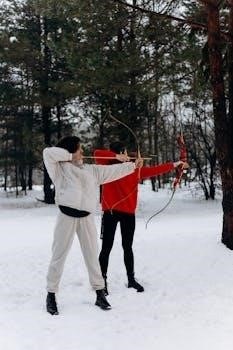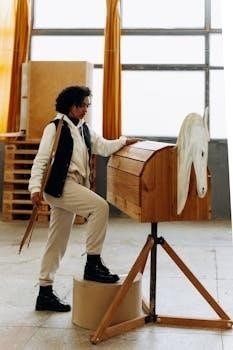the most dangerous game story pdf


The Most Dangerous Game Story PDF⁚ An In-Depth Article Plan
This article delves into Richard Connell’s gripping short story, “The Most Dangerous Game,” examining its plot, characters, and themes. We will explore the hunter-hunted dynamic, the story’s ambiguous ending, and its connections to other works, such as “The Hunger Games.”

“The Most Dangerous Game,” a classic adventure story penned by Richard Connell, first saw publication in 1924. It remains Connell’s most recognized work, captivating readers with its thrilling narrative and exploration of primal instincts. The story introduces Sanger Rainsford, a renowned big-game hunter, who unexpectedly finds himself in a terrifying life-or-death situation on a remote island. This narrative masterfully blends suspense with deeper themes, making it a subject of ongoing critical analysis and popular study. The tale’s enduring appeal lies in its dramatic portrayal of the hunter becoming the hunted, forcing readers to confront the dark aspects of human nature. It’s a compelling exploration of survival, morality, and the fine line between civilization and savagery. The story’s action-packed plot and thought-provoking themes have secured its place as a cornerstone of short story literature. Its influence is evident in its comparisons to other works that explore similar themes of high-stakes competition and the human will to survive.
Richard Connell and His Work

Richard Connell, born in 1893 and passing away in 1949, was an American author and journalist, widely recognized for his short stories and novels. Despite his varied literary output, “The Most Dangerous Game,” published in 1924, remains his most celebrated and enduring work. Connell’s writing style is often characterized by its suspenseful pacing and exploration of complex characters, often placed in extreme situations. His stories frequently delve into themes of survival, morality, and the inherent duality of human nature. While “The Most Dangerous Game” is his most famous contribution, Connell produced a diverse range of works, showcasing his versatility as a writer. He was a keen observer of the human condition, often using his fiction to explore the darker aspects of society and the individual psyche. His stories often feature vivid imagery and gripping narratives that continue to resonate with readers today. Connell’s career spanned several decades, leaving behind a legacy marked by his ability to craft compelling and thought-provoking tales.
Plot Summary and Analysis of the Story
“The Most Dangerous Game” centers around Sanger Rainsford, a renowned big-game hunter, who finds himself shipwrecked on Ship-Trap Island. He encounters General Zaroff, a sophisticated and wealthy Cossack, who has grown bored with hunting animals and has turned to hunting humans for sport. Zaroff lures unsuspecting sailors to the island to become his prey. Rainsford initially becomes the hunted, forced to participate in this twisted game. The story unfolds as a thrilling cat-and-mouse chase, with Rainsford using his hunting skills to evade Zaroff. The plot is driven by the increasing tension between the hunter and the hunted. Rainsford’s survival hinges on his wit and ability to adapt to the situation. Ultimately, Rainsford confronts Zaroff, leading to a final showdown. The climax is left ambiguous, prompting readers to question the true outcome of the encounter, and the implication is that Rainsford becomes the new hunter.
The Setting of Ship-Trap Island
Ship-Trap Island, the isolated and ominous setting of “The Most Dangerous Game,” plays a crucial role in shaping the narrative’s suspense. This remote island, shrouded in mystery and superstition, is a place where the traditional rules of civilization are abandoned. The island’s treacherous shores and dense jungle create a perfect hunting ground for Zaroff’s deadly game. Its isolated location makes it difficult for anyone to escape and serves as a container for the twisted game. The island acts as a symbolic representation of man’s primal nature, far removed from the norms of society. The setting’s darkness and unknown dangers heighten the tension. The island’s chateau, with its imposing towers, contrasts sharply with the wild surroundings. This contrast emphasizes the duality of civilization and savagery; The isolated nature of the island also contributes to the psychological impact on Rainsford, who is far from home and his familiar world. The island is a character in itself, impacting the action.
The Characters⁚ Rainsford and Zaroff
The central characters of “The Most Dangerous Game,” Sanger Rainsford and General Zaroff, represent contrasting facets of human nature. Rainsford, initially a renowned big-game hunter, embodies the conventional view of the hunter as superior. He is confident in his abilities and believes in the clear distinction between hunter and hunted. However, his experience on Ship-Trap Island forces him to confront his own vulnerability. Zaroff, on the other hand, is a refined and cultured Cossack who has become bored with traditional hunting. He seeks a more challenging prey, humans, and views them as mere animals for his sport. Zaroff’s intellectual and sophisticated demeanor masks a dark and primal nature. He believes that his superior intellect justifies his actions. The interaction between these two characters explores the transformation of Rainsford from hunter to hunted, forcing him to confront the darker aspects of humanity. Their contrasting philosophies and actions form the core of the story’s conflict, ultimately blurring the lines between predator and prey.
The Hunter vs. The Hunted Dynamic
The core of “The Most Dangerous Game” revolves around the stark dichotomy between the hunter and the hunted, a dynamic that is constantly shifting throughout the narrative. Initially, Rainsford is the confident hunter, believing in his dominance over the animal kingdom. However, his accidental arrival on Ship-Trap Island forces him to confront the terrifying reality of becoming the hunted. This shift in perspective leads Rainsford to question his own assumptions and ethics. General Zaroff, the hunter in this scenario, views his human prey as a mere challenge, an ultimate game to be played. His detached and intellectual approach to hunting highlights the disturbing aspects of his character. The story brilliantly uses the hunt to explore the primal instincts of both the hunter and the hunted. As Rainsford becomes prey, he discovers his own hidden resourcefulness and a desperate will to survive, revealing that the distinction between hunter and hunted isn’t as clear as he once thought. The narrative reveals how easily these roles can be reversed, challenging the reader’s perception of power and morality.
Themes Explored in “The Most Dangerous Game”
Richard Connell’s “The Most Dangerous Game” delves into several profound themes, exploring the dark side of human nature and the fragility of civilization. The story examines the thin line between the civilized hunter and the savage beast, questioning the morality of hunting when the prey is another human being. The narrative also explores the primal instincts for survival and the will to live, forcing Rainsford to confront his own capacity for violence and ruthlessness when pushed to the limit. Furthermore, the story touches on the theme of power and the abuse of it, as Zaroff uses his wealth and position to indulge in his sadistic desires. The story raises questions about the nature of good and evil and the extent to which society can suppress man’s basic, predatory drives. The ambiguous ending encourages further contemplation about the corrupting influence of violence and the potential for man to become the very thing he despises, blurring the lines between hunter and hunted, predator and prey.
Man’s Primal Nature and Civilization
“The Most Dangerous Game” explores the tension between man’s primal nature and the veneer of civilization. The story suggests that beneath the cultivated exterior, humans retain their basic, predatory instincts. General Zaroff, with his refined tastes and sophisticated demeanor, embodies this duality. He is a man of culture, yet he indulges in the savage act of hunting humans. This reveals how easily civilization can be cast aside, exposing the violent tendencies lurking within. Rainsford, initially a hunter himself, is forced to confront his own capacity for savagery as he becomes the hunted. The island setting, isolated and untamed, symbolizes the breakdown of civilized norms, where the basic struggle for survival reigns supreme. The narrative questions whether civilization is merely a superficial construct, easily stripped away when faced with life-or-death circumstances, revealing the primal hunter that exists in every man. The story implies that the line between civilized man and savage beast is surprisingly thin, and it is only in the context of the extreme situation that this line is tested and found to be so easily crossed.
The Morality of Hunting
Richard Connell’s “The Most Dangerous Game” raises profound questions about the morality of hunting, challenging the reader to consider the ethics of taking a life for sport. Initially, Rainsford, a renowned hunter, views animals as mere targets, displaying little empathy for their suffering. However, his perspective shifts drastically when he becomes the hunted, forcing him to confront the true horror of being the prey. The story blurs the line between hunter and hunted, suggesting that the roles can easily be reversed, and that the supposed superiority of the hunter is a fragile concept. Zaroff’s twisted logic of hunting humans because they are the “most dangerous game” exposes the dehumanizing potential of a hunter’s mentality. The story questions whether there is an inherent difference between hunting animals and hunting humans, and if the thrill of the chase can ever justify the taking of life. Ultimately, “The Most Dangerous Game” compels us to examine our own assumptions about power, violence, and the respect for all living creatures.
Survival and the Will to Live

“The Most Dangerous Game” powerfully explores the primal instinct for survival and the lengths to which an individual will go when faced with a life-or-death situation. Rainsford, initially a confident and skilled hunter, is stripped of his power and forced to rely on his wits and resourcefulness to avoid becoming Zaroff’s next victim. The story showcases the raw desperation that arises when one is hunted, pushing Rainsford to employ tactics he might never have considered in a conventional hunt. He transitions from a hunter who views his prey as something to be conquered, to a prey that must fight with every fiber of his being just to survive. This transformation highlights the potent force of the will to live, demonstrating that when survival is at stake, the boundaries of morality and civilization can easily blur. The story underscores the idea that humans are capable of adapting and overcoming seemingly insurmountable obstacles, driven by their innate desire to live. This relentless pursuit of survival reveals the inherent savagery that can lie beneath a veneer of civility.
Comparisons to “The Hunger Games”
The chilling narrative of “The Most Dangerous Game” resonates with Suzanne Collins’s “The Hunger Games,” as both stories explore the disturbing concept of humans hunting humans for sport and entertainment. Both narratives feature a protagonist who is forced into a deadly game, showcasing their journey from participant to active resister. Similar to Katniss Everdeen, Rainsford is initially a skilled individual thrust into a brutal competition where he must fight for his survival. The stories share a common theme of the wealthy and powerful manipulating the less fortunate for their amusement, raising questions about morality and the nature of entertainment. Both works depict a world where the lines between hunter and hunted, and civilization and savagery, are blurred, forcing the reader to confront the darker aspects of human nature. The suspenseful action and thought-provoking themes in both stories contribute to their enduring popularity and critical acclaim, highlighting the timeless appeal of tales that examine man’s capacity for both cruelty and resilience.
The Ambiguous Ending and Its Interpretations
The conclusion of “The Most Dangerous Game” is deliberately ambiguous, leaving readers to ponder Rainsford’s actions and motivations after he confronts Zaroff in his bedroom. The final line, “He had never slept in a better bed,” implies Rainsford’s victory but also raises questions about his future. Did he simply defeat Zaroff to survive, or has he become a replacement hunter, perpetuating the cycle of violence? The ambiguity encourages multiple interpretations, suggesting that Rainsford may have adopted Zaroff’s mindset and is now prepared to hunt humans himself. This open-ended conclusion underscores the story’s exploration of the fine line between hunter and hunted, suggesting that the experience may have fundamentally changed Rainsford. The fact that Rainsford chooses Zaroff’s bed, out of all the beds in the chateau, only further underscores the ambiguity of the ending. This choice raises questions about the possibility of Rainsford now planning to lure unsuspecting sailors to the island to continue the deadly game.
The Zodiac Killer Reference
A chilling connection has been drawn between “The Most Dangerous Game” and the infamous Zodiac Killer. In letters sent to newspapers, the Zodiac Killer included a cipher, which some believe references the story’s central theme, that “man is the most dangerous animal of all to kill”. This possible link adds a layer of intrigue to the story, highlighting the terrifying potential of humans as predators. The 1932 film adaptation of “The Most Dangerous Game” is also mentioned in the 2007 film “Zodiac,” further reinforcing the connection. While it’s uncertain whether the Zodiac Killer was directly influenced by the story or if the idea is coincidental, the parallel between the killer’s actions and the story’s premise is unsettling. This reference to real-life violence underscores the dark themes explored in Connell’s work, solidifying its lasting relevance and impact. It creates a haunting echo of the story’s exploration of humanity’s primal nature.